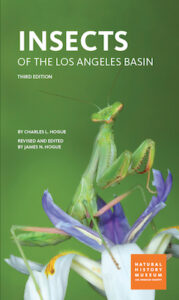A friend of mine once asked “why don’t people watch insects the same way they watch birds?” It’s a fair question. After all, many insects – such as butterflies and a good many beetles – are distinctively patterned or colored in such a way that an amateur could learn to identify them on sight – and in truth, butterfly watching does indeed have a certain number of devotees. But then as I began to explain to him that while there are a “manageable” variety of birds to be seen most regions, the number of insect species found in similarly sized areas would be positively bewildering. Add to this the fact that many insects are cryptic in their habits, and that depending on the family – or even the order in some cases – a good number are only minimally described or for that matter even distinguishable from one another by anyone with less than an entomology degree, and the answer becomes obvious.
But that doesn’t mean that there isn’t a very good reason not to make an effort to learn at least the basics of the fascinating variety of insects that surround us each day. And if on any of those days you find yourself in the Los Angeles basin, the process of doing so is decidedly easier than it would be in many other places due to the recent publication of the third edition of Charles L. Hogue’s Insects of the Los Angeles Basin by the Natural History Museum of Los Angeles County (NHMLA).
As the curator of entomology at NHMLA for thirty years, Dr. Hogue became famous for both his expertise in the field – particularly for his work in cultural entomology – as well as for his enthusiasm in conveying a better understanding of insects to the general public. For this reason, the original and second editions of this book have become widely known and highly regarded by professionals and amateurs alike. Unfortunately for enthusiasts of entomological studies, he died in 1992. However his legacy lives on, as for this third edition, his son James, a PhD in aquatic entomology who is the manager of biological collections in the department of biology at California State University, Northridge, and a research associate at NHMLA, has provided the revisions and updates needed after more than twenty years to bring the book in line with new discoveries in the field.
Not so much a field guide as a very well-written and easy-to-follow overview of the more easily noticed – as well as publicly noteworthy (or notorious) – members of the various orders contained within the Class Insecta, as well as a few representatives the Arachnida, and even a few centipedes, millipedes, pillbugs, a snail, a slug, and a land planarian, Insects of the Los Angeles Basin describes and depicts over 500 different species in a way that brings not only their own natural history into better perspective but also quite often addresses their role in the ecosystem and in our own lives as well. And to make the work even more interesting, Drs. Hogue and Hogue explain just what a remarkably cosmopolitain insect world the Los Angeles basin is due to the extraordinary amount of commercial activity from around the world flowing into and out of it each and every day.
Even as a dedicated naturalist, I don’t know that I’ve taken up very many guidebooks – field or otherwise – that I could recommend as both reference works and as being suitable for casual reading, however with Insects of the Los Angeles Basin I am delighted to do precisely that. I took a copy of the book along in my shoulder bag on a recent trip to Los Angeles, reading it on the plane to and from, as well as over breakfasts at Starbucks (receiving the expected mix of quizzical as well as horrified looks from nearby patrons – although that may have been due to the fact that I was reading a book rather than staring at a phone) and at other moments of opportunity. And at no time did I find myself becoming “bogged down” in excessive or hard-to-follow details, nor did I find any one chapter too long to read in either a public or private sitting. The text skips continuously along, mixing scientific with cultural information and even a fair bit of humor, and the included photos and illustrations provide a superb complement to each species entry.
And lest I conclude prematurely and risk giving the completely incorrect impression that Insects of the Los Angeles Basin is only of interest or use to those living in or traveling to that area, it should be noted that such an extraordinary job of explaining the various orders is done by Hogue Père et Fils that most anyone with an interest in learning the insect (and arachnid) life in their own respective geographic areas would do well to read it. Indeed, as so many species found in the Los Angeles basin come from somewhere else, it is quite likely that a few of your own region’s might be described in it as well.
 Title: Insects of the Los Angeles Basin (Third Edition)
Title: Insects of the Los Angeles Basin (Third Edition)
Author: Charles L. Hogue, revised and edited by James N. Hogue, updated preface by Dr. Brian Brown
Publisher: Natural History Museum of Los Angeles County
Pages: 464 pp., 500+ photographs and detailed line drawings
ISBN-13: 978-0938644446
Published: August 2015
In accordance with Federal Trade Commission 16 CFR Part 255, it is disclosed that the copy of the book read in order to produce this review was provided gratis to the reviewer by the publisher.
